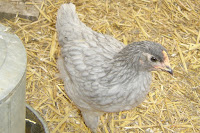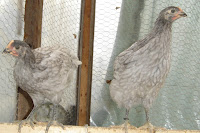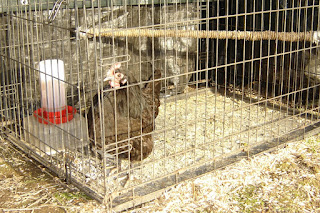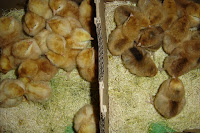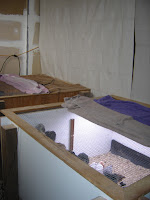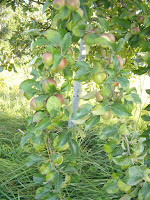My Little Farming Blog
A bit of McCackle as I update what I learn and discover while trying to raise chickens and garden.
Monday, April 15, 2024
Easy Pull Large Hoop Coop Design
Saturday, April 13, 2024
And then there were 25...
In February, we received 71 chicks from a no-kill, NPIP hatchery located in the Midwest. I have been really pleased with this hatchery. I have received three batches from them. The health of the chicks are very good when they arrive. As with any hatchery situation, there are bound to be a few that fail to thrive, but so far, with this hatchery, we usually only lose one or two.
Last weekend, we rehomed 45 of the chicks at the ages of six weeks and seven weeks. We have 25 left. 15 of those are promised out for rehoming over the next three weeks. That will leave us with 10 of the originals received in February. Fingers crossed that none are roosters this year.
Two of this year's originals do have some health issues. One has a cervical deformity that does not seem to slow her down as she is growing at the seem rate at the rest, she just looks a bit odd. The others don't seem to notice her deformity. Then we have a dwarfish pullet. A Rhode Island Red. She is fast but has been picked on a little, with some feathers missing from her backside. She will stay with us on the farm. She's not slow or sluggish like the dwarf we had a couple years ago. She may simply be more like a bantam.
Next week, we will pickup 50ish Cornish Rock Crosses, and six pullet Color Pack Blue Layers that we will likely keep for ourselves but may rehome some at six weeks.
Hen Survived Impacted and Sour Crop - Treatment We Used
I kept a diary of the process of treating (but almost culling) our hen who had a softball sized impacted crop that we discovered a month ago. Honestly, really thought we were going to need to put her out of her misery after the first few days. Anyways, I'm sharing my diary for others who may find it useful.
Please forgive any typos... I don't plan to "fix" the original errors on the diary.
NOTE-I am not a Veterinarian, or Vet Tech, or trained in medical procedures. Use my research at your own risk.
~~**~~**~~**~~**~~**~~**~~**~~**~~**~~**~~**~~**~~**~~**~~**~~**~~
March 18 - Discovered Hen has impacted crop and sour crop - Isolated her with just water and vitamins - no food. No access to any grass, etc., that she might try to ingest. We did have some hemp shaving on the floor of the crate that she seemed to claw at and flip out of the crate. She had clawed most of the feathers off her breast from her discomfort.
*I will point out that, unlike about 50% of the online suggestions for sour crop, I did not turn my hen upside down to try to drain her at any point in this healing process. We don't have poultry veterinarians in the region, and even with surgery, there is no guarantee of survival, although, I'm certain that it would minimize the distress of both the chicken and the chicken owner, and have been a quicker process, if the bird survived the surgery.
March 19 - Crop was still very distended and a baseball sized mass all bound with rough edges - still no food - No poohs from overnight. Gently massaged to "reshape" the mass throughout the course of the day being careful not to force anything up her esophagus.
March 20 - Day two - No poohs. Crop felt less distended but mass still pretty large. Hen drank vitamin water only and we gave about 3cc of olive oil through her beak using method of lifting her head and holding it gently extended while opening the beak and squirting a little down the side of her throat a little at a time, giving her the ability to swallow between each small amount. No food offered. - Gently massaged to "reshape" the mass throughout the course of the day being careful not to force anything up her esophagus.
March 21 - She's in distress although her comb color and eyes are bright. We are preparing to cull her to end her distress. The course of the day was similar to yesterday; vitamin water, olive oil, massage, and trying to reassure her. Gave her some of the smallish pieces of #2 grit.
March 22 - Situation Change - She poohed some green stuff! Gave her another small amount of the smaller grit, more fresh water with vitamins. Not ready to cull just yet. The Oil and Massage routine again. She's feisty today.
March 23 - She poohed again and eat some scrambled eggs coated in Olive Oil today. A little more grit offered. *Picked up Monistat 7 per a sour crop treatment recommendation on Murano Chicken Farm Blog. Her eyes are still bright but her comb has spots of white on the tips. Making certain to remove any food at the end of each day so that we are treating her with Monistat in the morning without new food in her crop.
Note - when she started eating wet-ish food, we would put the olive oil over the food and she would ingest the oil without the distress of us drippling it down her throat. She got to the point of actually licking the oil off the plate! So, even though it is not mentioned every day, olive oil was part of the feeding process everyday until the 4th week.
March 24 - Mass is getting smaller than original and softer. The mass was easier to massage and move. Not massaging as often. Only twice per day. Gave 0.5cc Monistat the same way we were giving her olive oil. Tried to give her scrambled eggs an hour after the medication but she would not eat it. Gave her more grit. She ate a handful of grit. Removed the food at bedtime.
End of Week 1
March 25 - Poohed again. Mass is about half the size - still softish. Gave her morning dose of Monistat, massaged mass, and gave her some canned catfood with a tablespoon of olive oil. She ate the catfood. Fresh water with RACV. She ate a little grit.
March 26 - Situation Change again. Poohed again. Mass has become smoother, got much smaller, and a lot softer. Morning dose of Monistat, gentle massage and hour later gave her cat food with oil, but only ate a little. Another massage. More grit. Food removed at bedtime.
March 27 - Started a ferment of chick starter feed. She had another Pooh overnight. Used same routine as yesterday. Wouldn't eat cat food or eggs, but did eat a little of the dry chick start feed. Not much. Did eat some more grit.
March 28 - A BIG green pooh today! Each day noticing the mass is getting smaller. Same morning routine with Monistat on empty stomach, gentle massage. Ate a little cat food with oil. Seems a bit more alert. Gentle massage in the evening with small amount of grit. Continuing to remove any leftover food each night.
March 29 - Started another batch of fermented food as a backup just in case she likes it. Another green pooh overnight. The mass is a lot smaller and almost the size of walnut. Same morning routine, massage, and fed the fermented chick feed (about 2 tablespoons) with tablespoon of olive oil. She loved it! Gave her one more tablespoon of the fermented feed. She cleaned it all up. Gentle massage, grit and remove food plate.
March 30 - Started another batch of fermented food. More pooh that became more brownish in color. The same morning routine. Last Dose of Monistat. Gave her more grit. Fed her the next batch of fermented feed BUT she did not want it. (later realized it was not "fermented" long enough she only likes the feed if it has fermented between 60 to 72 hours)
March 31 - Started another batch of fermented food. Mass is all gone! Crop is flat, and nothing to massage. Coloring in her comb is back to a bright pink. Eyes are still bright. She ate a little dry chick starter. Removed food at bedtime.
End of Week 2
April 1 - Keeping the fermenting process going daily until I know for certain that she is all better. No new pooh. No mass but her crop feels like it is full of jelly, even though she had no food this morning. Gently massaged it. Did More Sour Crop research. Refreshed her water with RACV (3/4 tsp/quart). More grit. She wouldn't eat the fermented food with olive oil today. Gave her some scratch in olive oil and she ate a little. Removed food at bedtime.
April 2 - Watery reddish pooh overnight. The bubble of watery stuff still in her crop. Comb still nice and pink. Eyes still bright. Back to the Monistat treatment. She ate more grit and a couple tablespoons of the fermented feed along with a tablespoon of oil added. (Note - oil is not used in the fermentation process).
April 3 - A little watery pooh. More Monistat and she ate four tablespoons worth of the ferment, 2 tablespoons in the morning and 2 more in the afternoon, finishing both before bedtime.
April 4 - Several big firm poohs, some green and some brown. Another dose of Monistat. She ate more grit, and six tablespoons of the fermented feed with olive oil over the course of the day.
April 5 - A small watery pooh. The jelly bubble is a lot smaller. Another dose of Monistat. She ate six tablespoons of the fermented feed over the course of the day.
April 6 - A very large watery pooh. The jelly bubble was gone this morning! Another dose of Monistat. She ate more grit and eight tablespoons of the fermented feed over the course of the day.
*I did learn there are some other digestive aids that can improve chicken's sour crop is teaspoon or two of Pomegranate Juice added to their water, and small amount (1/8 tsp) of cinnamon bark liquid extract (not essential oil) added to their feed. Two separate researches were done on Broilers in the past 10 years, and both studies found that these supplements helped reduce yeast growth in the chickens' digestive systems without antibiotics because of the anti-microbial nature of the pomegranate and cinnamon bark. It took me a while to find these two suggested items in formats that were straight and undiluted. I will supplement with these items over the next week even though, in truth, I think we have her on the mend. We will try the supplements while she is still on the Monistat, and then start to use pro-biotics after we are certain we have the sour crop under control, and no longer need the Monistat or other anti-microbial supplements. Although fermented feed has some probiotics, there is no guarantee that there are enough probiotics in the feed alone, so I will supplement with chick pro-biotics starting in about two to three days while starting to wean her off the pomegranate and cinnamon extract as the week progresses. I have discovered that I can refrigerate any extra three day fermented feed and she will still eat it the next day like it was freshly fermented! Yay!
April 7 - Several large dark brownish poohs overnight. Another flat chest start to the day. One last dose of the Monistat. Fed 10 tablespoons of fermented chick start feed adding a few drops of cinnamon bark liquid extract to the feed during the last feeding. A mid-day pooh that looked more normal. She acts like she is starving, which is encouraging, although I don't want to over feed her at this point. But she is eating all the mash that is given, and taking in a few grains of grit, as well, even though she doesn't need grit with the fermented mash. I will give her some scratch tonight just before bedtime. Fingers crossed. I was able to find some chick pro-biotics that I can add to her feed tomorrow, now that she is off the Monistat.
End of Week 3
April 8 - Good poohs over night that looked more normal. Still no sign of sour crop. Added Cinnamon Bark extract in addition to a sprinkle of probiotics to her fermented mash. No Olive Oil at this point. She ate two big helpings of about 1/3 cup each and then ate some dry chick crumbles. Late in the afternoon, gave her more grit and a handful of grains. Full crop and not spongy.
April 9 - More good poohs over night. Still no sign of sour crop. No Cinnamon Bark extract today, just a sprinkle (1/8th teaspoon) of probiotics over her fermented feed servings. She ate about 2/3 cup of the fermented feed plus several small scoops of all purpose poultry pellets. Not been adding any oystershell nor extra calcium to her diet. Just trying to get her healthy. Have noticed that the luster shine in her feathers has returned.
April 10 - Another great morning. Ate almost a cup of fermented mash and some more pellets. She is putting weight back on and she is more attentive, pacing, wanting to go back to her group. More chatty.
April 11 - Doing really well. Had refeathered her breast area. Ate about 6 to 8 ounces of fermented feed and then ate some pellets to top off her day. She is lonely. She looks quite healthy now. Placed her back in the flock in the evening after sunset.
April 12 - Hen is back in the flock today. Although her crop protrudes more than it used to, it is digesting fully over night. She is readjusting to the group.
April 13 - Looking really good. Will keep a close eye on her over the next week, just in case.
Took almost four weeks!
~~**~~**~~**~~**~~**~~**~~**~~**~~**~~**~~**~~**~~**~~**~~**~~**~~
These are some of the items I used to treat the hen over the course of the past month.
 Generic Monistat (Miconazole 7) 0.5cc oral each treatment using 1.0mL needleless syringes. First thing in the morning, on an empty stomach and waited one hour before feeding any food.
Generic Monistat (Miconazole 7) 0.5cc oral each treatment using 1.0mL needleless syringes. First thing in the morning, on an empty stomach and waited one hour before feeding any food.  Bragg Organic Apple Cider Vinegar, 0.75 teaspoon/quart water on days I didn't use Nutri drench or Pomegranate Powder.
Bragg Organic Apple Cider Vinegar, 0.75 teaspoon/quart water on days I didn't use Nutri drench or Pomegranate Powder.  Poultry Probiotic, 0.125 (1/8th) teaspoon per 2 - 3 oz. serving of fermented feed daily, starting the day after ending the Monistat treatments. I did not add the probiotics to the water.
Poultry Probiotic, 0.125 (1/8th) teaspoon per 2 - 3 oz. serving of fermented feed daily, starting the day after ending the Monistat treatments. I did not add the probiotics to the water.Sunday, March 31, 2024
Busy Busy Busy Start to Spring 2024
The chicks we picked up in February are almost six weeks old. Of the 71 we received, 70 have survived, and we have them in a large grow-out space now, protected from the elements but, at the same time, giving them "la luz natural" so that they will be all ready for coop living next week. We still have some large warmers in place for those that are still not quite ready for chilly nights. When it rains, it is kind of chilly too. But, they are having a blast in their temporary space.
In the meantime, my two Golden Comets were approaching their second year, so I sold them to a local farm and picked up three Comet pullets that are just now starting to lay. That was a few weeks ago. I just finished up the quarantine and have shifted them into the flock. Moved the entire flock on fresh grass, stocked them up with grit and oystershell, filled their waterers with vitamin supplements, and filled the feeder full to ensure that they all lack for nothing, reducing the chances of any major fights. Each day, I go out with treats. Yesterday was sunflower seeds. Today, they received strawberries.
About two weeks ago, I noted that one of my hens was under the weather, her crop was all bloaty and I felt a larger than typical lump in her crop. I isolated her with water and nothing else to eat for the night. The next day, the bloaty was less but the impact felt like a bunch of rocks, was not very squishy, and she had not poohed. We squirted 5cc of olive oil into her (by mouth) for two days and tried massaging the mass. In the meantime, I picked up monistat 7 (linked to article as potential treatment) to treat the sour crop. When I knew she was finally poohing again, I gave her a little grit to help with digestion. The family has been working together for treating her every day.
She obviously has an impacted crop still (but much better) and had sour crop (seems to be gone). We treated the sour crop with monistat 7 giving her .5cc per day (no oil during this treatment) for seven days. The mass continued to decrease in size, and gradually got softer. Keeping her water medicated with vitamins, and tried a variety of soft foods to help her digest the mass while, at the same time, keeping her nourished. She liked the prescription canned catfood for a couple days, then turned her beak up at it. Tried mashed cooked vegetables... not wanted. Tried mashed fruit we had frozen in the freezer. She ate a little, and poohed a little, but, it was obvious there was not a lot of nourishment with the fruit.
Read about how to ferment chicken food and since we have chicks, we have the 20% protein chick start available. Fermented the chick start for three days and it was a hit. I didn't want to give her too much on the first day, but yah. She poohed a lot of the mass that keeps getting a little smaller and softer each day. After a week, we were done giving her the monistat, but we added olive oil to the remaining fermented food that we had stored overnight in the fridge. Takes about three days to ferment and we have a small "running" production of fermented feed going now. On the second day with the fermented feed, we warmed the mash a bit, added 5cc of olive oil and gave her about three level tablespoons of the stuff. She poohed right away, and so I gave her two more tablespoons in the afternoon. She eats it quickly, and has perked up quite a bit. Like I say, this has been two weeks worth of treatment and we are not done yet. There is no evidence of any sour crop or bloating, so I think we are just working on getting that mass to digest.
And I will note, that early on, twice, we almost culled her because she was in so much distress. Several sour crop and impacted crop articles indicated that the only way to "unbloat" her was to tip her upside down to let the stuff drain out. But I had read just as many articles about the fact that if this is done incorrectly, the chicken can accidentally get fluid into her lungs and die a painful death. I will admit that it took a couple of days for the bloating to go away by not feeding any more food, and only giving her water the first two days. Giving her the oil at the beginning of each day, then massaging the mass several times per day helped move things along to the point that she could pooh, and once the pooh started happening, we knew we were on the right track. When she ate the catfood and then ate the grit, we felt a huge relief. Prior to that point, the first few days, each time we assumed we had hit a wall and that she was suffering more than necessary, we would get things ready to cull her, only to come back to see an amazing rebound on her part. She told us, indirectly, that she was NOT done yet!
There are no vets in the area that treat chickens. There are some that treat "exotics" but even those are hesitant to treat chickens. Plus, cutting open the chicken to get the impact out is no guarantee for survival and is very expensive for a chicken that, at the most, is about $50 to replace. But, my main concern was to minimize her suffering as much as possible. She IS much better, her coloring never got too bad, plus, her eyes never dulled during all of this. So, I'm just watching her closely and working on her, day by day. Today, she too received a fresh strawberry as a treat along with her fermented mash with a squirt of olive oil. She is poohing a lot of "green" which, I assume, indicates that, day by day, she's getting rid of a mass of "grass" in her gut. Slowly, but....
UPDATE: 4/1/24 I checked on the hen again (like normal) to massage the mass and decide what to try giving her today, to feel an empty crop. Nothing was stuck in there today! Now to wean her back onto her regular pellets. Today and tomorrow, I'll still feed her the fermented chick feed. Then will give her some all purpose poultry pellets on Wednesday and Thursday to see how she does with digesting those. If all goes well, will give her some oyster shell so that we can get her back into the flock and no longer keep her in isolation. Wanting her to be back on track before that.
Then, on top of everything else, our brown duck came up lame again this spring. Last year was mid-April, I believe, that occurred after an April snow/ice storm. This year, we have had a lot of cold rain that just puddles out in the field, making for a very sloggy pasture space. The chickens, at least have cover over their pen, but that's not an easy option for the duck corral, short of making them stay inside their coop every day. So, yah, the start of bumblefoot for the duck on the other foot this year.
Normally, March is the last of the freezing temps, but in 2022 and 2023, mid-April brought in some really cold temps with snow. Hoping we don't get that this year! Too many plants have green buds on them already. Throwing out fertilizer around all the trees, shrubs and fruit bushes. I would hate to lose any of them again! I have a lot of sheets and covers this year, though, as a Just In Case, but the baby trees out in the field are just too many to cover!
About a little over half of the chicks will be going to new homes next week and then we will be down to raising the rest to the 10 weeks stage, integrating some into our flock while the rest will go to their new homes. I totally oversold the Color Pack Blue Layers I had ordered (they were popular) so I will be brooding a new batch of the Color Pack in mid-April specifically for our flock. In August, I'll thin out the older flock and keep about a dozen of the new gals for eggs.
Saturday, March 9, 2024
Chilly Winter Rolling into Spring 2024
Haven't posted anything lately. Not that we are not doing anything, just nothing to really post about. We did get some really cold and blustery weather mid-January with temps dropping down to 0°F and knocking lots of trees down. Lasted about 10 days and ended with freezing rain. So that was exciting. Thankfully, this year, we only lost power for a few hours, a couple of times, and so we didn't need to spend a lot of time trying to keep birds alive. As it was, we were able to keep them locked inside their coops with lights and water fount heaters that allowed them to drink and eat and stay relatively warm.
February wasn't too bad. Mostly wet until the end of the month, when it started getting cold again, and had a few snow showers that didn't stick for very long.
We ordered about 70 chicks from the hatchery located in the mid-west of the country. The chicks typically arrive on the second day after shipping and always seem really healthy. We did lose one chick that seemed to be a failure to thrive situation. It simply was not growing. But, the rest have survived beyond the typical die-off stage/ So we are up to our armpits with chicks at the moment.
|
|
|
|
|
|
|
|
|
|
|
|
|
|
|
|
|
|
|
|
|
We still have eight of the pullets we started last spring. Plus, we have an older Barred Rock that was returned to us by a customer who decided she wasn't wanted any more. That Barred still lays an occasional egg, and settled in with the flock.
We just sold the two 20 month old hens we had held over from 2022. They are still laying fairly well, but we are changing things up and plan to buy three Novogen pullets that are just starting to lay (that were raised on another farm last October).
This year's breeds are Barred Rock, Blue Sapphire (Rock), Gold Comet, Color Pack Blue (lays blue eggs), Rhode Island Red, Buff Orpington, and Welsummer.
Wednesday, August 2, 2023
A Heavy Apple Crop 2023
I should have thinned these long ago! My Bad! Branches are near breaking and there is no more room, literally, for apples to grow! Will figure out what I can do with unripe apples.
While many people had bumper crops of cherries around here, in June this year, for the first time in a long while, we only had one cherry. I guess our apples decided to make up for that?
Still struggling with getting the raspberries to grow. I had one survive from last year of the three I planted. So I bought two more, and planted them, and one of those is trying to hang in there while the other from last year is still doing its thing. I don't know how long I need to wait for the berries to actually produce. I guess I should read up on that. So, I guess I will be planting again next year, in hopes that I can have three plants, eventually. The biggest issue are the moles. Ugh!
Blackberries, on the other hand, have certainly thrived this year. I did bake a fresh blackberry pie today. The fruits of my picking labor, I guess.












